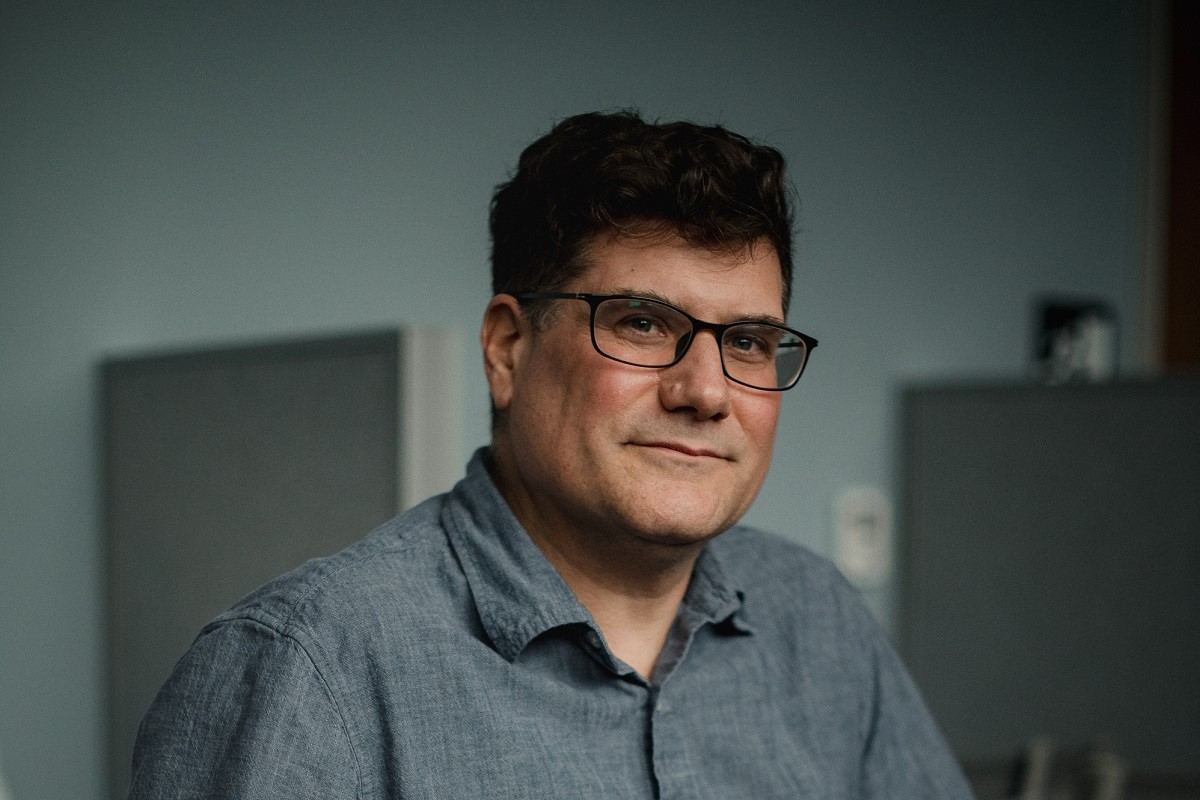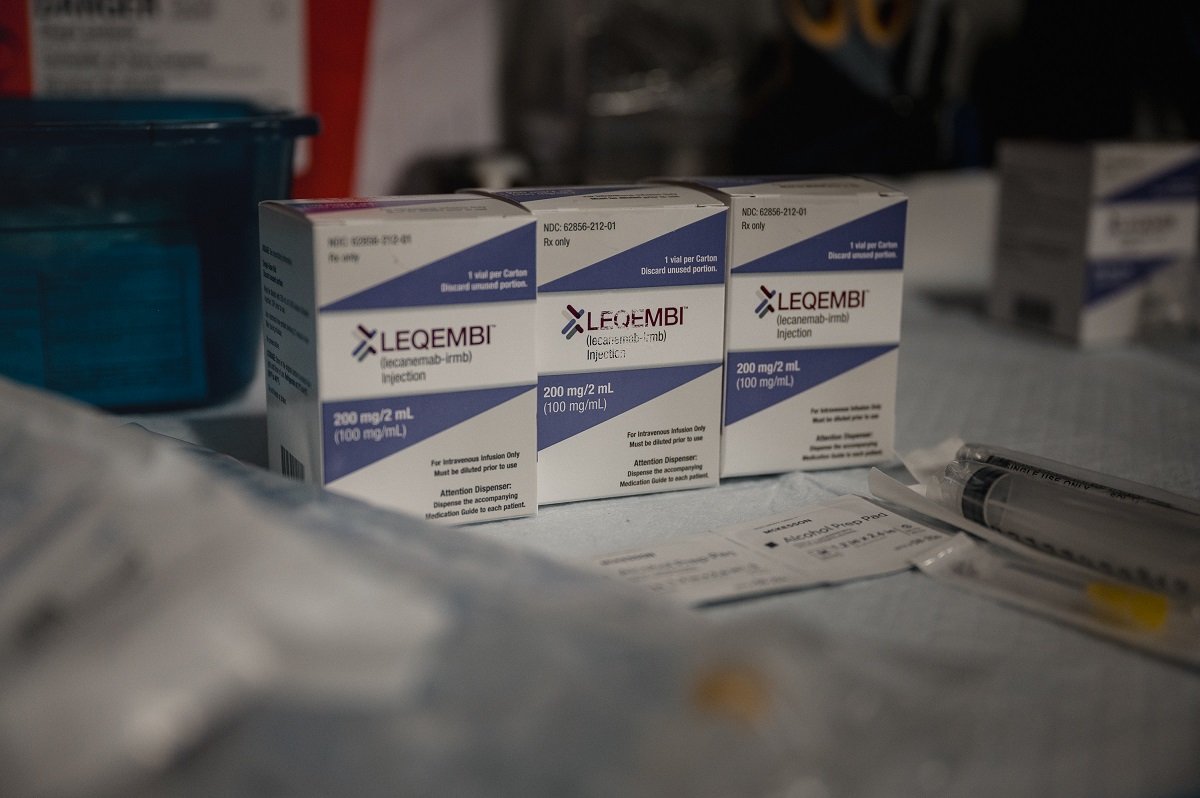
Robert Williford with wife Cynthia Byron-Williford at their home in Cheltenham, Pa. He was diagnosed with early Alzheimer’s disease in 2022.
14:34 JST, January 30, 2024
ABINGTON, Pa. – Wrapped in a purple blanket, Robert Williford settles into a quiet corner of a bustling neurology clinic, an IV line delivering a colorless liquid into his left arm.
The 67-year-old, who has early Alzheimer’s disease, is getting his initial dose of Leqembi. The drug is the first to clearly slow the fatal neurodegenerative ailment that afflicts 6.7 million older Americans, though the benefits may be modest. The retired social worker, one of the first African Americans to receive the treatment, hopes it will ease his forgetfulness so “I drive my wife less crazy.”
But as Williford and his doctors embark on this treatment, they are doing so with scant scientific data about how the medication might work in people of color. In the pivotal clinical trial for the drug, Black patients globally accounted for only 47 of the 1,795 participants – about 2.6 percent. For U.S. trial sites, the percentage was 4.5 percent.
The proportion of Black enrollees was similarly low for Eli Lilly Alzheimer’s drug, called donanemab, expected to be cleared by the Food and Drug Administration in coming months. Black people make up more than 13 percent of the U.S. population.
The paltry data for the new class of groundbreaking drugs, which strip a sticky substance called amyloid beta from the brain, has ignited an intense debate among researchers and clinicians. Will the medications – the first glimmer of hope after years of failure – be as beneficial for African Americans as for White patients?
“Are these drugs going to work in non-Whites? And particularly in Blacks? We just don’t have enough data, I don’t think,” said Suzanne E. Schindler, a clinical neurologist and dementia specialist at Washington University in St. Louis. “In general, the default is that they will work the same in everybody, but we don’t really know that for sure.”
The situation casts a spotlight yet again on the decades-long failure of researchers to reflect the increasingly diverse character of the patient population in the United States, and underscores the stark disparities in Alzheimer’s treatment and care. Black Americans develop the disease and related dementias at twice the rate of their White counterparts, but are less likely to receive specialized care and are diagnosed at later stages, studies show. That’s an urgent problem considering that the new drugs must be used early to have an effect.
In addition, a perplexing new issue appears to be contributing to low Black enrollment in trials and is fueling a debate among experts about the role of race, genetics and other factors. To qualify for the main trial for Leqembi – developed by the Japanese pharmaceutical giant Eisai and the biotechnology company Biogen of Cambridge, Mass. – participants were required to have elevated levels of brain amyloid, a defining characteristic of Alzheimer’s, and symptoms such as memory loss.
But brain scans showed that the African American volunteers were less likely to have excess amyloid than White patients and thus were excluded from the trial at higher rates. Almost half of Black applicants failed to meet the amyloid threshold, compared with 22 percent of White volunteers, according to Eisai. A similar pattern occurred with the Lilly drug and in some other studies, and sometimes involved other people of color, including Hispanics.
Experts are baffled by the findings. Why would amyloid levels – thought to be a key driver of Alzheimer’s – be different in people with similar cognitive problems?
“Is it the color of someone’s skin? Almost certainly not,” said Joshua D. Grill, an Alzheimer’s researcher at the University of California at Irvine. “Is it a difference in genetics? Or other health conditions, like cholesterol, blood pressure or vascular health? Or is it something else, that we haven’t measured?”
While the biology of Alzheimer’s is almost surely the same regardless of race, some researchers say the patients themselves might be different because of underlying health conditions. Some older Black patients diagnosed with Alzheimer’s, they say, might actually have vascular dementia stemming from heart disease, hypertension and diabetes – all conditions more prevalent among African American patients.
The risk of vascular damage also could be increased by a lack of access to health care and years of exposure to racism, as well as genetics, some experts say. And many patients could have a constellation of pathologies driven by other factors, they add.
Whatever the cause, experts say, the bottom line is the same: Patients who do not have excessive amounts of the sticky brain protein should not be treated with the amyloid-targeting drugs because the therapies are unlikely to work and pose substantial risks, including potentially deadly bleeding in the brain.
But that raises the specter of another disparity. If it turns out that a lower proportion of Black dementia patients and other people of color have excess amyloid, they could be left behind as the drug industry races to develop amyloid-reducing treatments. To counter that, experts are urging companies to accelerate work addressing other potential drivers of cognitive decline and to develop combination drugs with multiple targets.
“If we are just targeting amyloid, we can just miss a large potential population that might benefit from treatment,” said Lisa L. Barnes, a neuropsychologist at Rush University in Chicago.
‘A brain is a brain’
For now, the question remains: What should Black patients and their doctors think about the anti-amyloid drugs?
The answer, experts say, depends largely on the level of amyloid in their brains.
More than a year ago, Williford was diagnosed with early Alzheimer’s by David C. Weisman, a neurologist at Abington Neurological Associates, a large practice north of Philadelphia that treats patients and conducts clinical trials for drug companies. The clinic was one of the test sites for Leqembi.
After Leqembi received full FDA approval last summer, Williford underwent tests to determine whether he was a good candidate for the drug. One test – a lumbar puncture, sometimes called a spinal tap – showed elevated amyloid in his brain. That means Williford and similar patients are likely to benefit from an anti-amyloid medication regardless of their race or ethnicity, Weisman and several other experts said.
“A brain is a brain is a brain, whether it is Asian, Hispanic, African American or White,” Weisman said. “A patient is either a good fit or a bad fit, and Robert is a good fit.”
Williford, who spent years working with troubled families in Philadelphia, began having memory problems a few years ago, said his wife, Cynthia Byron-Williford, 59.
“You could tell him almost anything, and he would almost immediately forget,” she said. “If I asked him to make a peanut butter sandwich for our grandson, he would come back three times and say, ‘What am I supposed to do?’”
With few treatment options, many physicians say they will offer anti-amyloid therapy to any patient who has elevated levels of the substance and passes safety tests.
Barry W. Rovner, a neurology professor at Thomas Jefferson University in Philadelphia, said he would not hesitate to offer Leqembi to African American patients who tested positive for amyloid. But, he added, because of the low numbers of Black individuals in the Leqembi trial, “I would say, ‘Look, this has not been tried in many Black people, so we don’t know precisely how it is going to work. But you don’t know precisely how it will work in any person.’”
From a research perspective, “You could say, as a group we don’t know if Black individuals respond the same way to anti-amyloid drugs because we don’t have the data,” Washington University’s Schindler said. “But on an individual level, it is different. If I had a Black patient who was amyloid-positive, I would start him on these drugs.”
But some Black patients might not be comfortable with the medication.
Zaldy S. Tan, director of the memory disorders center at Cedars-Sinai Medical Center in Los Angeles, said when African American patients are informed about the risks and benefits of Leqembi, and about the sparse data available for Black individuals, some will “take a pause and question whether they are willing to accept the uncertainty” and challenges of receiving the every-other-week infusion and multiple follow-up tests.

David C. Weisman, a neurologist who specializes in Alzheimer’s disease, conducts clinical trials and treats patients at Abington Neurological Associates, north of Philadelphia.
A promise of diversity
The best way to know for sure how drugs for Alzheimer’s – and other diseases – affect different populations is to have more diversity in trials, experts agree. But research participation by Black Americans and other people of color has been held down for years for several reasons.
The 20th century’s infamous Tuskegee syphilis study created long-standing mistrust about trials within the African American community. Men were left untreated to suffer and die even after an effective treatment emerged for the bacterium.
Alzheimer’s research, meanwhile, has long been centered in memory clinics at elite academic institutions, which tend to attract well-heeled patients with health insurance and other resources. The clinics have served as effective recruiting grounds for trials that end up with a predominantly White enrollment.
“We have done a poor job of making African American Alzheimer’s research inclusive,” said John Morris, a neurologist at Washington University in St. Louis. More than two decades ago, he created an African American advisory board at the school’s Knight Alzheimer Disease Research Center after realizing only 3 percent of trial participants were Black.
Others also are redoubling efforts to increase diversity. John Dwyer, president of the Global Alzheimer’s Platform Foundation, a nonprofit that runs trials, said the organization has sharply increased participation by people of color by sending dedicated teams of African American and Latino professionals into communities to build relationships with physicians and personnel at health centers, senior centers and places of worship. They stress to the communities how much they can benefit from the studies, he said.
Stephanie Monroe, vice president and senior adviser of health equity and access at the advocacy group UsAgainstAlzheimer’s, noted that low Black enrollment is not limited to Alzheimer’s trials. If all the drugs that have not been tested on people of color were eliminated, the shelves of pharmacies would be nearly empty, she said.
“That doesn’t work when you are almost a 50-50 minority/majority population,” Monroe said.
The FDA has issued guidelines for industry designed to bolster diversity in studies, while the National Institute on Aging recently pledged to prioritize funding requests that are “appropriately inclusive.”
The low Black enrollment in studies is just the latest controversy involving the anti-amyloid drugs. For years, earlier versions of the drugs failed repeatedly in trials. By contrast, Leqembi, in an 18-month trial, showed unambiguous, if modest, benefits, slowing disease progression by about 27 percent, or roughly five months. The drug, administered every other week, carries a list price of $26,500 a year.
In July, Lilly reported that its anti-amyloid drug, donanemab, was even more effective at removing amyloid. But like Leqembi, it can cause serious side effects, including brain hemorrhages. Some doctors think the drugs will provide bigger benefits when taken for a longer period or earlier in the disease, but others say the medications, which require repeated MRIs to check for side effects, leave much to be desired.
Both Eisai and Lilly said they are working hard to increase diversity in clinical trials. In the meantime, they said, patients with elevated amyloid should benefit from the anti-amyloid drugs, regardless of race or ethnicity.
“We have no pathophysiological reason to expect different efficacy between races and ethnicities for Alzheimer’s treatments that remove amyloid,” Lilly said in a statement.
Eisai acknowledged that the Leqembi trial was not designed to test the drug in individual racial and ethnic subgroups. But it said in a statement that the totality of the evidence indicated that “all patients, regardless of ethnicity, benefited from treatment” with the drug.
“We and the U.S. FDA – as evidenced by the agency’s approval of Leqembi – believe that the benefits and risks in these patient populations and races has been established,” the company added. Eisai said volunteers who did not pass the amyloid threshold did not have Alzheimer’s and should be assessed for other conditions.
In an interview, Teresa Buracchio, acting director of the FDA’s Office of Neuroscience, said the agency “did not see a notable difference by race” in safety and effectiveness in the limited data available on subgroups in the Leqembi trial.
But other experts were skeptical, saying the number of Black patients in the Leqembi trial was too low to know whether the medication is safe and effective for African Americans. “Without having a representative population, it is impossible to assess,” said Barnes, of Rush University. Some researchers suggested that patients in underrepresented populations should wait for future advances in treatment.

The Alzheimer’s treatment Leqembi is prepared for administration.
‘We just want to get going’
On a recent day, nurse Christine Besso bustled in and out of Williford’s infusion room at the neurology clinic, taking his vital signs and inserting an IV line. “Let’s get this party started,” she said.
Byron-Williford, watching the process from a nearby couch, said she was not concerned about the low numbers of African Americans in the Leqembi trial.
“I think it will work or not work based on the individual,” she said, adding with a laugh, “and if it doesn’t work for him, it is because he is ornery.”
Byron-Williford said her husband’s health problems accelerated a few years ago after his son, who was in his early 20s, died unexpectedly. Williford became depressed and lost his appetite. Last summer, when he went to pick up his wife at a nearby hair salon, he drove around, lost. She later confiscated his car keys.
In the clinic, shortly after Williford’s infusion began, Weisman stopped in to check on him and discuss possible side effects. When Williford asked him how long he would be on the drug, Weisman shrugged, saying it depended on how he did on the drug and on test results.
“We are getting on an airplane, and we don’t even have a destination airport yet,” Weisman said. “We just want to get going.”

Nurse Christine Besso sets up an IV to administer Williford’s first treatment of Leqembi while his wife, Cynthia Byron-Williford, watches.
"News Services" POPULAR ARTICLE
-

American Playwright Jeremy O. Harris Arrested in Japan on Alleged Drug Smuggling
-

Japan’s Nikkei Stock Average as JGB Yields, Yen Rise on Rate-Hike Bets
-

Japan’s Nikkei Stock Average Licks Wounds after Selloff Sparked by BOJ Hike Bets (UPDATE 1)
-

Japanese Bond Yields Zoom, Stocks Slide as Rate Hike Looms
-

Japan’s Nikkei Stock Average Buoyed by Stable Yen; SoftBank’s Slide Caps Gains (UPDATE 1)
JN ACCESS RANKING
-

Keidanren Chairman Yoshinobu Tsutsui Visits Kashiwazaki-Kariwa Nuclear Power Plant; Inspects New Emergency Safety System
-

Imports of Rare Earths from China Facing Delays, May Be Caused by Deterioration of Japan-China Relations
-

University of Tokyo Professor Discusses Japanese Economic Security in Interview Ahead of Forum
-

Japan Pulls out of Vietnam Nuclear Project, Complicating Hanoi’s Power Plans
-

Govt Aims to Expand NISA Program Lineup, Abolish Age Restriction





















